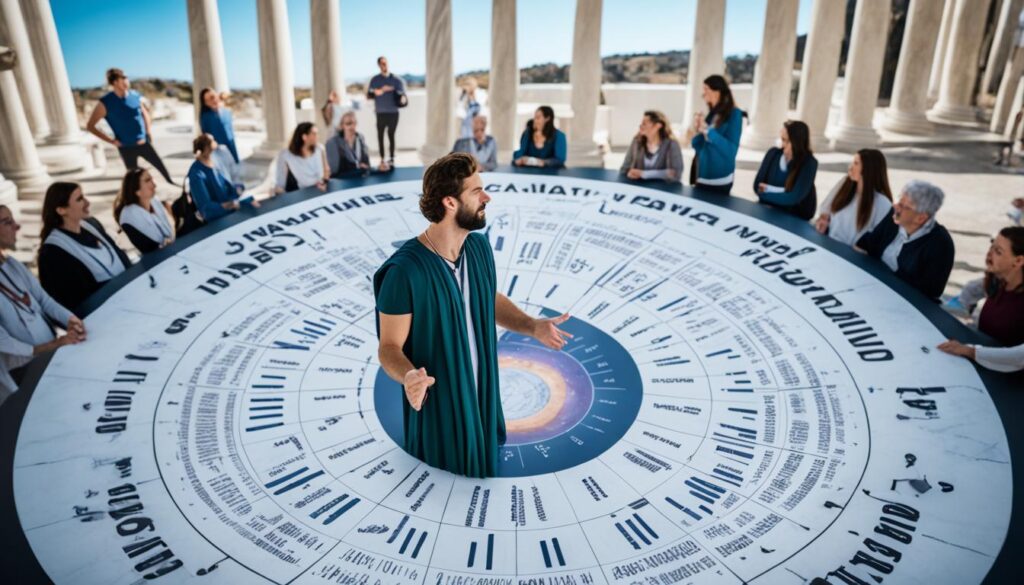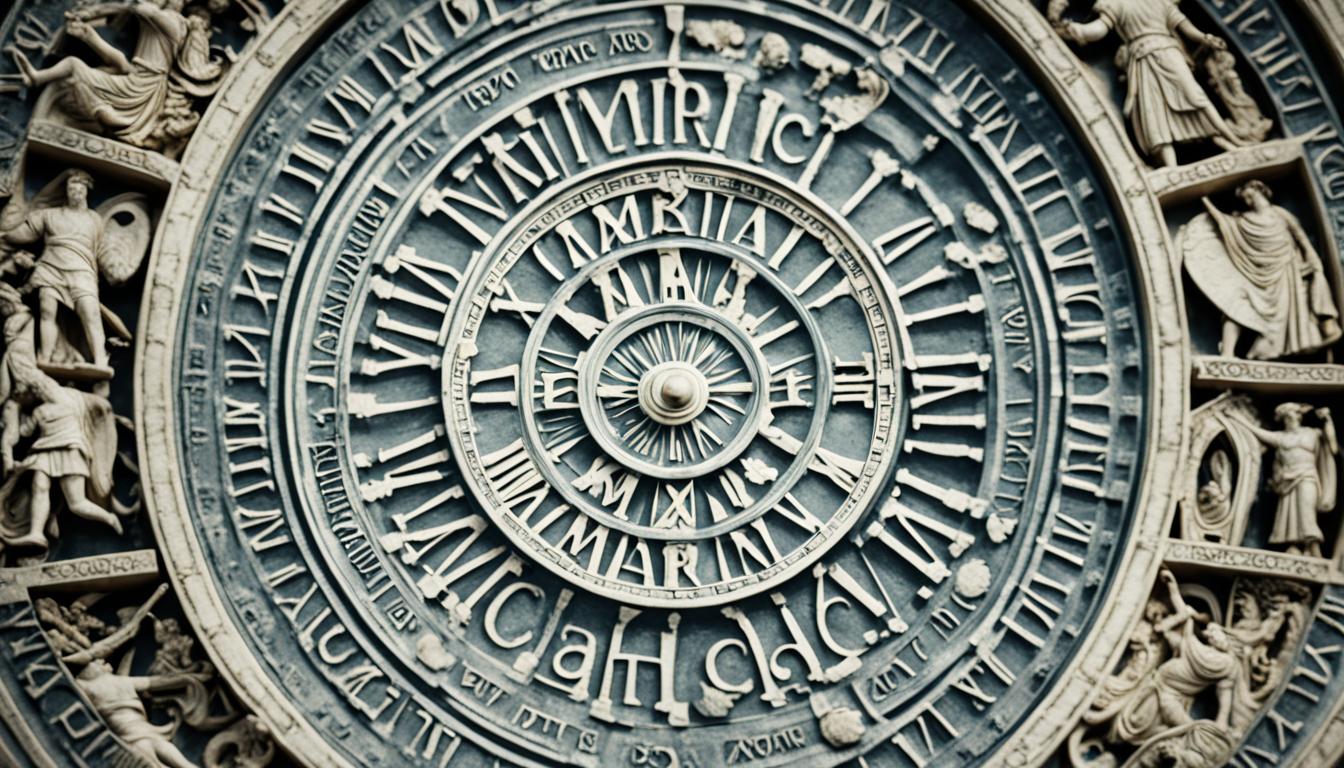In the ancient Roman calendar, March (Martius) was originally the first month of the Roman year. This early calendar is believed to have been attributed to Romulus, the legendary founder and first king of Rome, although it likely evolved from other dating systems used by ancient civilizations like the Babylonians, Etruscans, and Greeks.
The Romans tied each year to the founding date of their city, with 753 B.C. considered year one of the Roman Republic. March signified a return to the active life of farming, military campaigning, and sailing after the winter months.
The placement of March as the first month held significant importance in the cultural and societal traditions of ancient Rome. It marked the beginning of the season of warfare and agriculture, which were central pillars of Roman society.
Key Takeaways
- March (Martius) was the first month of the year in the ancient Roman calendar
- The early Roman calendar is attributed to Romulus, Rome’s founder and first king
- Romans linked each year to the founding of Rome, with 753 B.C. as year one
- March signaled a return to farming, military campaigns, and sailing after winter
- The first month placement of March was significant to Roman cultural traditions
The Legendary 10-Month Roman Calendar
The ancient Roman calendar, often attributed to the legendary founder and first king of Rome, Romulus, was a fascinating example of early timekeeping. This 10-month calendar consisted of 304 days, with each month lasting either 30 or 31 days. The months were named Martius, Aprilis, Maius, Junius, Quintilis, Sextilis, September, October, November, and December, reflecting their numerical order from the beginning of the year.
The early Roman months were closely tied to the agricultural cycle and the lunar phases, with the calendar year beginning in March, which was named after Mars, the Roman god of war. This 10-month calendar was eventually replaced by a 12-month lunar calendar, which added the months of Ianuarius (January) and Februarius (February) to account for the remaining days of winter that were previously left unorganized.
Despite the addition of these two months, the lunar calendar still faced challenges in staying synchronized with the solar year. The discrepancy between the lunar and solar cycles led to the need for periodic adjustments and calendar reforms to maintain alignment with the seasons. These reforms would eventually lead to the development of more accurate and standardized calendars, such as the Julian calendar introduced by Julius Caesar in 45 BCE.
The 10-month Roman calendar serves as a testament to the ingenuity and adaptability of ancient civilizations in their quest to understand and measure time. Although it may seem primitive by modern standards, this early timekeeping system laid the foundation for the more sophisticated calendars that followed, shaping the way we organize and plan our lives to this day.
Lunar Reforms and Intercalation
In the seventh century B.C., during the reign of Rome’s second king, Numa Pompilius, the Roman calendar underwent a significant transformation to align with the lunar calendar. This reform saw the creation of two new 28-day winter months, Ianuarius and Februarius, by borrowing a day from each of the existing ten months. However, this change alone was not enough to keep the calendar in sync with the seasons.
To address this issue, the Romans introduced the concept of intercalation, which involved adding an extra month called Mercedonius every two or three years. This intercalary month was inserted between February and March to compensate for the discrepancy between the lunar and solar years. Despite this seemingly logical solution, the application of Mercedonius was far from consistent, leading to widespread calendar confusion.

The responsibility of managing the calendar fell upon the Roman priests, who wielded significant power in determining the dates of religious holidays, festivals, and days when business could be conducted. This authority, coupled with the inconsistent application of Mercedonius, resulted in a calendar that was often out of sync with the natural seasons. The lack of a standardized system for intercalation left the Roman calendar vulnerable to manipulation and political maneuvering, further compounding the issue of calendar confusion.
As the Roman Empire expanded and the need for a more reliable and consistent calendar grew, it became increasingly evident that the lunar-based system, even with the occasional intercalation of Mercedonius, was inadequate. The irregularities and confusion caused by this system would eventually lead to the development of more sophisticated calendar reforms, such as those implemented by Julius Caesar in the first century B.C.
March as Ancient Roman New Year
In ancient Rome, March was not only the first month of the calendar but also marked the beginning of the Roman New Year. The month, known as Martius, was named after Mars, the Roman god of war and guardian of agriculture, who was also considered an ancestor of the Roman people. As a result, March was a time of great significance, filled with numerous festivals and religious observances.
One of the most important celebrations during this time was the Feriae Marti, a festival dedicated to Mars. This event involved various rituals and sacrifices to honor the god and seek his protection for the coming year. Another notable celebration was Matronalia, which honored Juno Lucina, the goddess of childbirth, and celebrated mothers and the bonds of family.
March also marked the renewal of the sacred fire of Vesta, the goddess of the hearth. This ritual was performed by the Vestal Virgins, who were responsible for maintaining the eternal flame that symbolized the heart of Rome. Additionally, the month featured the procession of the Salii priests, who carried sacred shields through the city streets, performing elaborate dances and chanting hymns to Mars.
The spring equinox, which usually falls around March 20th or 21st, was another significant event during this time. The Romans saw this as a time of renewal and rebirth, marking the transition from winter to spring. As the Roman New Year began in March, the month was filled with a sense of optimism and hope for the future, with the various festivals and religious observances serving to unite the community and seek the favor of the gods for the coming year.
Julius Caesar’s Calendar Reforms
In 45 B.C., the legendary Roman general and statesman Julius Caesar implemented sweeping calendar reforms with the assistance of the renowned astronomer and mathematician Sosigenes of Alexandria. The resulting Julian calendar, a testament to their collaboration, revolutionized timekeeping in the ancient world. The new system comprised 365 days, with an additional leap year every four years to compensate for the quarter-day discrepancy in the solar year.
Caesar’s reforms not only improved the accuracy of the calendar but also established January 1 as the official start of the new year, coinciding with the day Roman consuls assumed office. This marked a significant departure from the previous Roman tradition of beginning the year in March. The Julian calendar’s innovations laid the groundwork for more precise and standardized timekeeping across the Roman Empire and beyond.
Despite the Julian calendar’s advancements, it was not without its flaws. The solar year is not precisely 365.25 days long, resulting in a slight discrepancy that accumulated over centuries. This issue was eventually addressed in 1582 by Pope Gregory XIII, whose modifications led to the creation of the Gregorian calendar, the system still in use today. Nonetheless, Caesar’s calendar reforms remain a profound and enduring legacy, a testament to the ingenuity and scientific understanding of the ancient world.

Leave a Reply